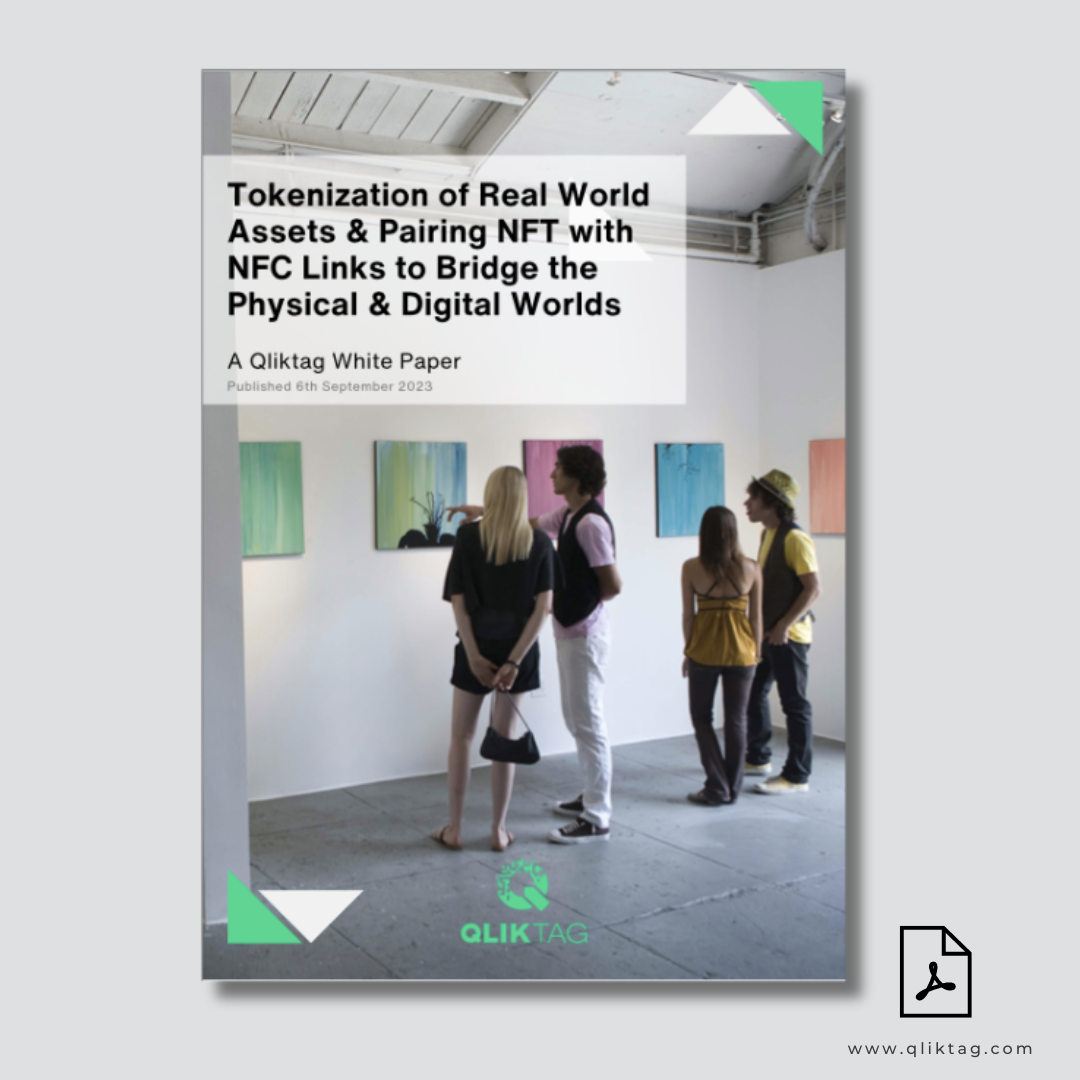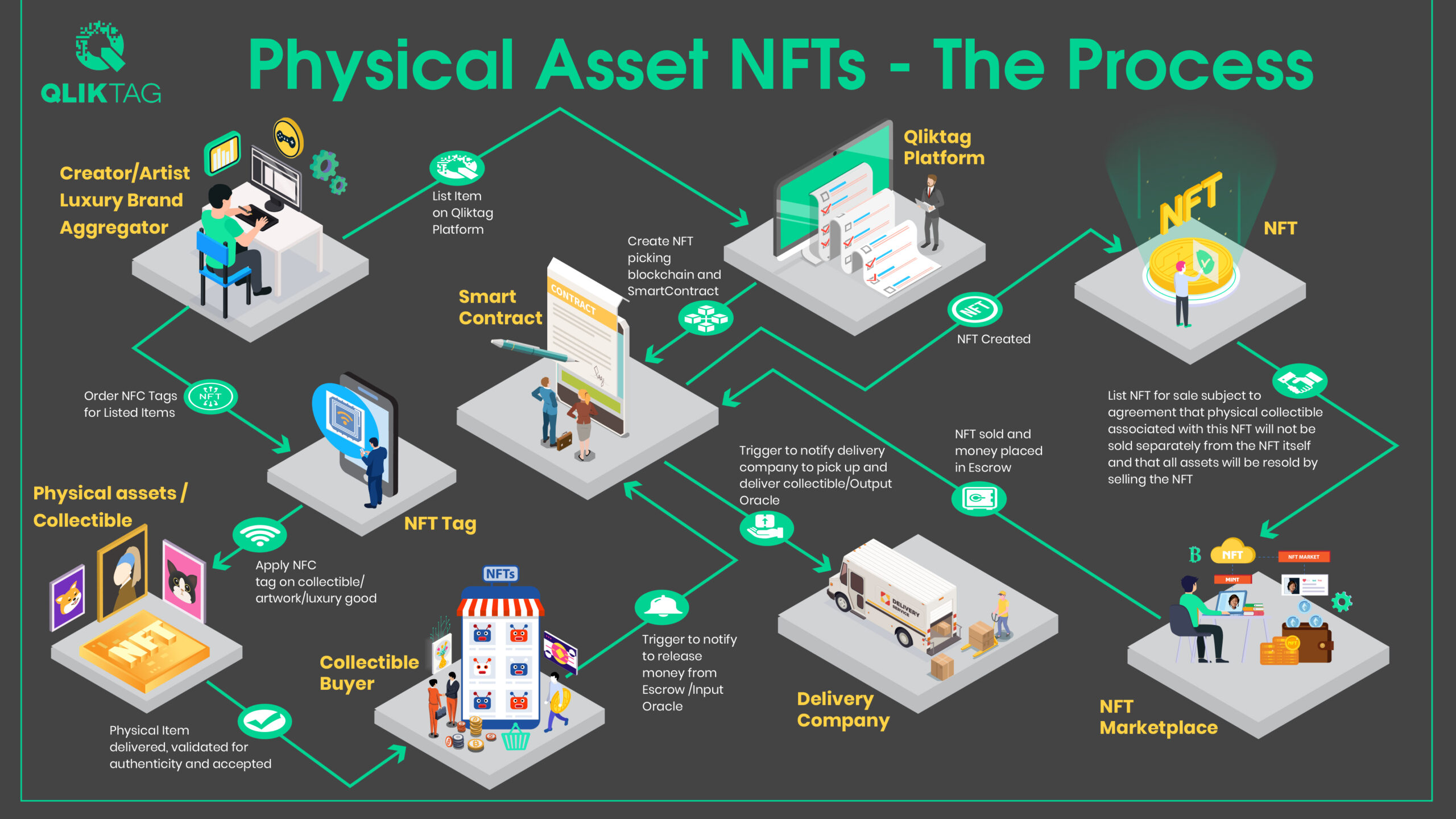Tokenization of Real World Assets
Today we have an ever increasing part of the global population spending more of their time in the digital world. People connecting within the metaverse, gamers interacting in digital realms, consumers transacting online and the fusion of the physical and digital realms has become a topic of immense significance. As technology continues to advance, our focus at Qliktag has been to bridge the gap between these two worlds through connected products and real world assets. Connecting real world assets to the digital world can be as simple as generating a web URL and generating a QR code which can be placed on the physical item to connect it to a digital experience or interaction on the web. However, this is easily copied, manipulated and lacks any security which is key in so many real world use cases where real world assets need to be linked to the digital world in a way that the link is inextricable, can not be replicated, shared over the internet, counterfeited and safeguards the value of both the physical and digital.
This is precisely where digital tokenization the use of Non-Fungible Tokens (NFTs), secure, dynamically generated Digital Link URLs and unclonable Near-Field Communication (NFC) links can come together to be seamlessly integrated with real-world assets and create secure connections between physical and digital domains.
The Key Technology Components Within the Qliktag Solution for Bridging the Physical with the Digital
Qliktag ID / Non-Fungible Tokens, or NFTs
To identify a real world asset or a physical product within the digital realm or the web, it needs to be “tokenized” or assigned a digital identifier. Essentially, much like a barcode number or a physical token representing something can be used to identify assets in the real world, the Qliktag Connected Products Platform first assigns a token / Qliktag ID on the cloud to each instance of an item added to the platform. Additionally, if the real world asset or item is to be paired with an NFT token where ownership transfers and tractions are to be maintained on a decentralized blockchain, then along with digital Qliktag ID, the NFT contract address, NFT token ID and Smart Contract Standard are tied to the asset within the Qliktag Platform to represent the physical asset and its ownership in the real world.
Secure, Unique Dynamic Digital Links
This is an absolutely key part of the solution when it comes to creating links between real world assets / physical products and the digital world. The real world asset exists physically within the world in the form that it is in. In the digital world however, that very same asset can exist as data, as a digital twin, as a digital experience tied to the physical item or as a digital interaction with the physical item. The Qliktag solution offers a complete drag and drop experience designer to design visual digital interactions and experiences. To be able to access the digital experience or interaction, there needs to be a digital link that can be accessible on the physical asset to connect it to its digital counterpart.
This where the Qliktag Connected Products Platform generates secure, unique links dynamically to represent the connection between every individual instance of the physical product or real world asset. This is done using the GS1 Digital Link standard which is a globally recognized URL format for identification of a physical product or asset and its representation in the digital world. Once these Digital Links are generated by the platform can be combined with a dynamic component which can interact with specialized NFC tags, they can be bulk exported for encoding into the NFC tags and embedded into the real world assets.
Unclonable Near-Field Communication NFC with Digital Authentication
The most glaring weakness of web URLs when it comes to creating links between an individual physical asset and it’s digital representation is the fact that it’s easy to copy, easy to replicate, simple to share with others via email or chat and doesn’t offer a secure link which can only be accessed physically through the physical product / real world asset. Also if the link is only to be accessible to the rightful owner of the physical asset or someone that is authorized to, traditional URLs or use of QR codes is ineffective. The Qliktag Solution uses secure type-4 NFC tags / chips which generate a unique key / passcode on every single tap which keeps changing and can not be used twice. This key generated by the chip within the printed electronic tag is combined with the Digital Link URL, encrypted with AES 128 encryption and sent back to the Qliktag Platform for authentication. This way, the link between the physical asset and digital experience / interaction within the digital world is:
- Authenticated
- Verifiable
- Unclonable
- Can only be accessed on the physical asset with embedded tag
- Can not be accessed if shared by email, messaging or online
- Can not be counterfeited
- Creates an inextricable link between the physical and digital versions of the asset
Additionally, when paired with an NFT token, the capability of the solution goes beyond physical item authentication to the ability to carry out ownership authentication and enabling access to certain digital features and capabilities only to those who are in custody of a valid NFT token. Effectively, anyone other than the owner of the physical asset with the NFT token can only access public information or features while with the ownership NFT token, restricted content, features and capabilities are unlocked. This capability opens up a world of possibilities and use cases.
These type-4 tags which are part of the technology solution for bridging the physical with the digital can be made available in a few different form factors and can be either embedded into the physical product / asset as part of the manufacturing process or applied to it.
The Power of Tokenization & Connecting Real-World Assets to the Digital World
While NFTs and tokenization limited to the digital realm is where the popularity and trends of trading NFTs originated, tokenization of real world assets in the physical world is where the immense untapped value and opportunity lies. Real-world assets, such as artwork, real estate, and luxury goods, have inherent monetary value, require security, ownership transparency, ability to authenticate, need for transactional contracts. As such, tokenization of these assets and integrating NFTs with these can amplify their value and accessibility, creating new possibilities for ownership and investment.
The power of smart contracts when inextricably linked to physical products or real world assets is an exciting prospect. Imagine royalty payments on artwork being paid out to the artist not just on the first sale, but on future sales and change in ownership throughout the life of the art. A possibility enabled by the use of smart contracts and pairing physical real world assets with NFTs.
The tokenization of real world assets and pairing with tightly bound digital capabilities also enables these physical assets to be:
- Serially identifiable
- Traceable
- Highly individualized
- Personalized
- Impossible to counterfeit
- Digitally transferable
- Enabled for fractional ownership
- Interactive
Above all, more valuable than just the physical item on its own.
The technology for tokenization of real world assets and inextricably pairing real world assets with the digital world has the potential to reshape industries, redefine ownership, and offer users unprecedented product experiences. As technology within this space continues to evolve, the fusion of these two realms will undoubtedly lead us to a world where our lives in the physical world and digital world are more seamlessly integrated.


Recent Comments